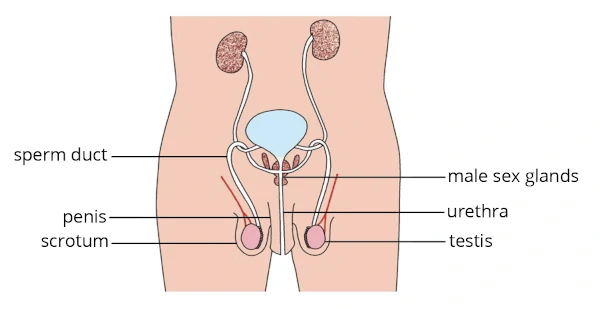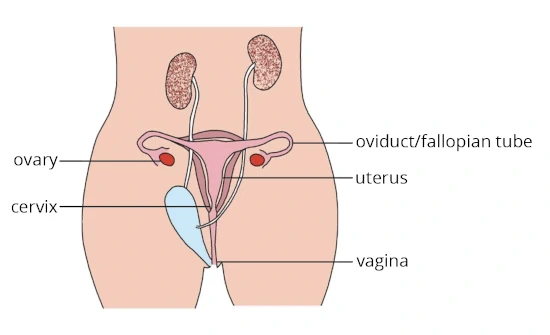Human Sexual Reproductive System
In this article, the following are the objectives that will be discussed.
- Discuss the purpose of reproduction.
- Identify the structures in the female and male reproductive system.
- State the function(s) of the structures in the female and male reproductive system.
Purpose of Reproduction
Every organism will eventually die. Hence, organisms must be able to reproduce in order to maintain the existence of their kind on earth. Therefore, reproduction ensures that the existence of the species is maintained on Earth.
Imagine if some of the organisms lose their ability to reproduce. These organisms will be extinct from the Earth!
Types of Reproduction
There are two types of reproduction:
- asexual reproduction
- sexual reproduction
Asexual Reproduction
Asexual reproduction is a form of reproduction which involves only one parent. Hence, no fertilisation is required. Therefore, the offspring produced from the parent cell is identical to the parent.
Sexual Reproduction
Sexual reproduction is a form of reproduction which involves two parents, one from the male and one from the female. This form of reproduction requires fertilisation.
In humans, the nucleus of the ovum produced by the female fuses with the nucleus of the sperm produced by the male, forming a zygote. Since the offspring receives genetic materials from both the male and female, they are not identical to the parents.
Male Reproductive System

Testis
The testis (plural: testes) produces sperm and male sex hormones, such as testosterone.
Scrotum
The scrotum, also known as the scrotal sac, holds the testis outside of the body cavity, to help maintain a lower temperature for the development of the sperm.
Sperm Duct
The sperm duct is a muscular tube that carries the sperm from the testis to the urethra.
Male Sex Gland
The male sex glands secrete a fluid that contain nutrients and enzymes, which provide the sperm with the energy to move. A mixture of this fluid and sperm is called semen.
Penis
The penis is the male reproductive organ, which becomes erect when sexually excited. Sperm are ejaculated through the penis during sexual intercourse.
Urethra
The urethra is a tube that extends from the bladder, through the penis, to the outside of the body. Urine and semen exit the body through the urethra.
Female Reproductive System

Ovary
The ovary produces eggs/ova and female sex hormones such as oestrogen and progesterone.
Fallopian Tube
The fallopian tube, also known as the oviduct, is a narrow muscular tube that connects the ovary to the uterus. Mature eggs released from the ovary are deposited into the fallopian tube, where fertilisation occurs.
Uterus
The uterus, also known as the womb, is where the fetus develops. The inner surface of the uterus is covered with a soft, smooth inner layer known as the uterine lining, which is important for the implantation of the embryo.
Cervix
The cervix is a circular ring of muscle present at the lower end of the uterus. It allows for menstrual blood to flow out into the vagina during menstruation.
Vagina
The vagina, also known as the birth canal, is a muscular tube, which joins the cervix to the outside of the body. It is also where semen is deposited into during sexual intercourse.
Revision Questions
Here are some questions for us to look into on the objectives of this article.
Question 1:
Determine whether the statement below is true or false.
“Almost all organisms are able to reproduce.”
- true
- false
Solution:
(A) true
Explanation:
Only a small fraction of organisms cannot reproduce as they are infertile, where they are unable to reproduce. It can be due to a genetic defect, accident or damage to their sexual organs.
Question 2:
Determine whether the statement below is true or false.
“Sexual reproduction always involves fertilisation.”
- true
- false
Solution:
(A) true
Explanation:
Sexual reproduction involves two parents, where one gamete is obtained from the male and the other gamete is obtained from the female. Hence, this requires fertilisation, which is the fusion of the nucleus of the male sex cell (e.g. sperm) to the nucleus of the female sex cell (e.g. ovum).
Question 3:
Which of the following is not a characteristic of asexual reproduction?
- The offspring are identical to the parent.
- No fertilisation is involved.
- It only requires one parent.
- It may involve two parents.
Solution:
(D) It may involve two parents.
Explanation:
Asexual reproduction only involves one parent while sexual reproduction involves two parents.
Question 4:
Which of the following is not part of the male reproductive system?
- ureter
- testis
- sperm duct
- sex glands
Solution:
(A) ureter
Explanation:
The ureter is a tube which connects the kidney to the urinary bladder. It is part of the urinary system. The ureter transports urine from the kidney to be stored in the urinary bladder.
Question 5:
Which of the following is not part of the female reproductive system?
- oviduct
- ovule
- cervix
- vagina
Solution:
(B) ovule
Explanation:
The ovule is the organ that forms the seeds of flowering plants.
Question 6:
Which of the following is the function of the scrotum?
- to ensure the temperature of tests is below body temperature
- to produce a fluid that is rich in nutrients
- to deliver semen and urine out of the body
- to produce sex hormones
Solution:
(A) to ensure the temperature of tests is below body temperature
Explanation:
The scrotum is located outside the body cavity to help maintain a lower temperature for the development of sperm.
Question 7:
Which of the following is the function of testes?
- to ensure the temperature of tests is below body temperature
- to produce a fluid that is rich in nutrients
- to deliver semen and urine out of the body
- to produce sex hormone
Solution:
(D) to produce sex hormones
Explanation:
The testes produce sperm and male sex hormones such as testosterone.
Question 8:
Which of the following is the function of the oviduct?
- to receive ovum during ovulation
- to sustain the growth of the embryo
- to receive semen during sexual intercourse
- to produce sex hormones
Solution:
(A) to receive ovum during ovulation
Explanation:
The oviduct, also known as the fallopian tube, is a narrow muscular tube, where mature eggs from the ovary are released into.
Question 9:
Which of the following is the function of the ovary?
- to receive ovum during ovulation
- to sustain the growth of the embryo
- to receive semen during sexual intercourse
- to produce sex hormones
Solution:
(D) to produce sex hormones
Explanation:
The ovary produces eggs (ova) and female sex hormones such as oestrogen and progesterone.
Question 10:
A rare condition might happen to a male whereby the testes do not move to the scrotum and stay in the abdominal cavity. Predict what will happen to the male.
- The male does not have any sex hormones.
- The male is infertile.
- The male has no abnormal condition.
- Sperm will not be produced.
Solution:
(B) The male is infertile.
Explanation:
The purpose of the testes being located outside of the body cavity, in the scrotum, is to help maintain a lower temperature for the development of sperm. Hence, due to a higher temperature within the body cavity, the maturation of sperm will be affected. Hence, the male will be infertile.
| Continue Learning | |
|---|---|
| Chemical Changes | Energy And Work Done |
| Transfer Of Heat Energy And Its Effects | Interactions Within Ecosystems |
| Electrical Systems | Transport System In Living Things |
| Interactions Through The Application Of Forces | Human Sexual Reproductive System |
| Acids And Alkalis | |


 SG
SG  VN
VN 
















